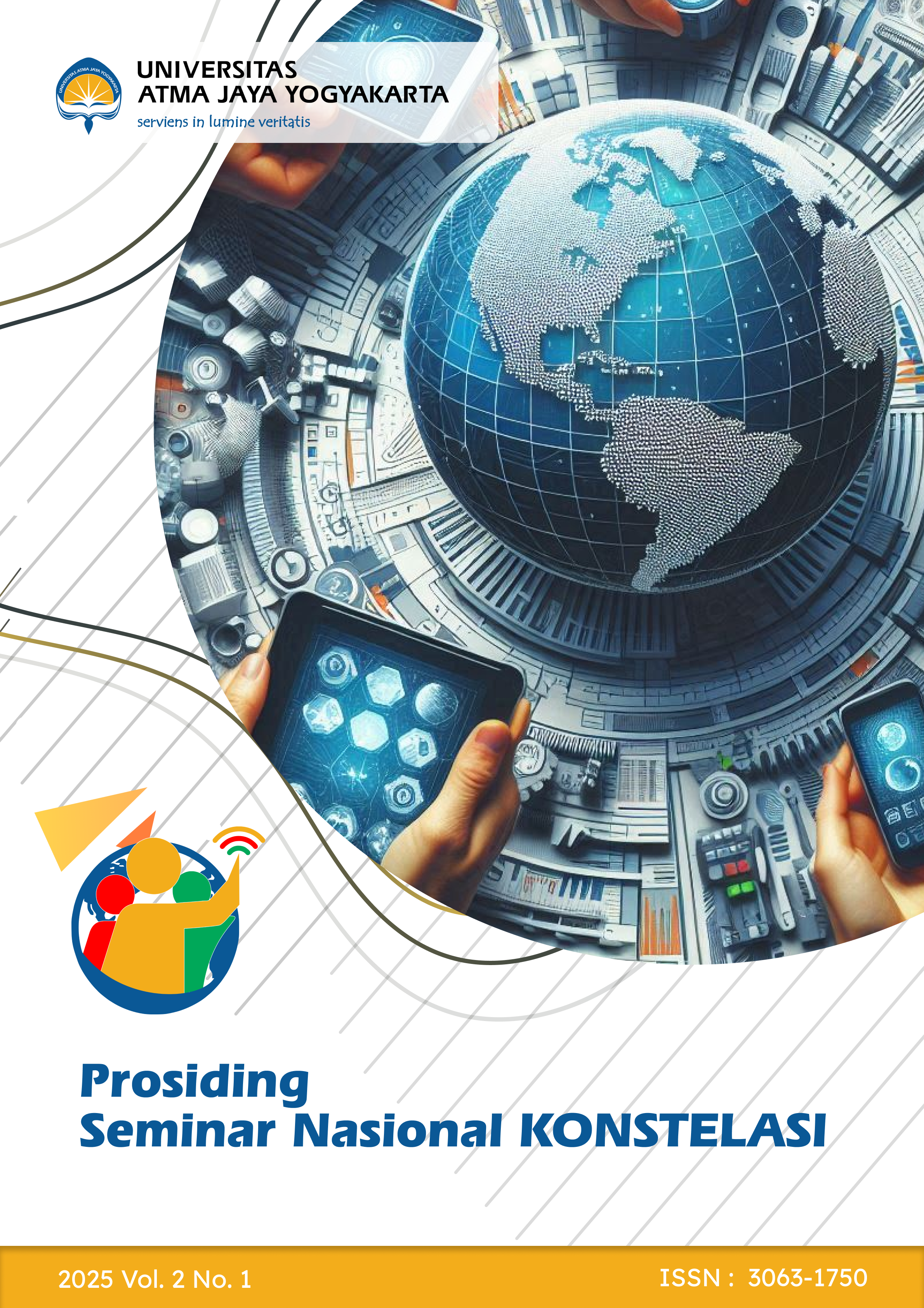Comparison Of Bisecting K-Means And K-Medoids Algorithm In Grouping Junior High School Students Based On Bebras Challenge 2023 Results
DOI:
https://doi.org/10.24002/prosidingkonstelasi.v2i1.11162Keywords:
Computational Thinking , Bisecting K-Means, K-Medoids , Silhouette ScoreAbstract
Improving the quality of education, especially Computational Thinking (CT) skills, is an important priority in the digital era. Bebras Challenge, an international competition to measure Computational Thinking. The results show the diverse abilities of Junior High School students, so that appropriate mentoring methods are needed. This study compares the Bisecting K-Means and K-Medoids algorithms to group students based on the results of the 2023 Bebras Challenge, along with their Indonesian, Mathematics, Science scores, and the duration of competition preparation. The study was conducted through data preprocessing, application of clustering algorithms, and model evaluation using Silhouette Score at the number of clusters k = 2 to k = 10, and running time. The results show two main groups, namely the first group of students with high understanding, fast processing time, and effective preparation. While the second group of students with low understanding due to less than optimal preparation. Bisecting K-Means showed the best performance with a Silhouette Score of 0.623 and an execution time of 0.005 seconds at k = 2. This study provides insights for educators and policy makers to design more effective data-based learning strategies.
References
[1] PISA 2022 Results (Volume I) . in PISA. OECD, 2023. doi: 10.1787/53f23881-en.
[2] J.M. Wing, Computational Thinking . IEEE, 2011.
[3] Herlina and Z. Ernaningsih, “Implementation of K-Means Clustering for Analysis of Elementary School Students’ Computational Thinking Understanding Level,” BUDIDARMA INFORMATICS MEDIA JOURNAL , vol. 7, no. 3, pp. 1405–1413, 2023, doi: 10.30865/mib.v7i3.6132.
[4] E. Seniwati, A. Sidauruk, Haryoko, and A. Lukman, "Clustering Performance Between K-means and Bisecting K-means for Students Interest in Senior High School," Building of Informatics, Technology and Science (BITS) , vol. 5, no. 1, June. 2023, doi: 10.47065/bits.v5i1.3624.
[5] E. Luthfi, A. Wahyu Wijayanto, and P. Statistika, “Comparative analysis of hierarchical, k-means, and k-medoids clustering methods in grouping the Indonesian human development index,” Jurnal FEB , no. 4, pp. 761–773, 2021, [Online]. Available: http://journal.feb.unmul.ac.id/index.php/INOVASI
[6] J. Han, M. Kamber, and J. Pei, “Data Mining. Concepts and Techniques, 3rd Edition (The Morgan Kaufmann Series in Data Management Systems),” 2011.
[7] A. Ramsauer, P. M. Baumann, and C. Lex, “The Influence of Data Preparation on Outlier Detection in Driveability Data,” SN Comput Sci , vol. 2, no. 3, May 2021, doi: 10.1007/s42979-021-00607-7.
[8] D. Sarkar, R. Bali, and T. Sharma, Practical Machine Learning with Python . Apress, 2018. doi: 10.1007/978-1-4842-3207-1.
[9] T. Budiwati, A. Budiyono, W. Setyawati, and A. Indrawati, “PEARSON CORRELATION ANALYSIS FOR CHEMICAL ELEMENTS OF RAINWATER IN BANDUNG,” Jurnal Sains Dirgantara , vol. 7, no. 2, 2010.
[10] F. Mayang Sari, R. Nur Hadiati, and W. Perinduri Sihotang, “Pearson Correlation Analysis of Total Population and Number of Motorized Vehicles in Jambi Province,” Journal of Statistics, University of Jambi , vol. 2, no. 1, 2023, doi: 10.22437/multiproximity.v2i1.25568.
[11] WR Safitri, “PEARSON CORRELATION ANALYSIS IN DETERMINING THE RELATIONSHIP BETWEEN DENGUE FEVER INCIDENTS AND POPULATION DENSITY IN SURABAYA CITY IN 2012 - 2014,” Journal of STIKES Pemkab Jombang , 2014.
[12] I. Kamila, U. Khairunnisa, and Mustakim, “Comparison of K-Means and K-Medoids Algorithms for Clustering,” Scientific Journal of Information Systems Engineering and Management , vol. 5, no. 1, pp. 119–125, 2019.
[13] S. Dwididanti and DA Anggoro, “Comparative Analysis of Bisecting K-Means and Fuzzy C-Means Algorithms on Credit Card User Data,” Emitter: Jurnal Teknik Elektro , vol. 22, no. 2, pp. 110–117, Aug. 2022, doi: 10.23917/emitor.v22i2.15677.
[14] R. Nainggolan, R. Wargain-Angin, E. Simarmata, and AF Tarigan, "Improved the Performance of the K-Means Cluster Using the Sum of Squared Error (SSE) optimized by using the Elbow Method," in Journal of Physics: Conference Series , Institute of Physics Publishing, Dec. 2019. doi: 10.1088/1742-6596/1361/1/012015.
[15] F. Faisal, L. Aliska Giopani, F. Ma'idatul, Z. Cindya Dwynne, S. Syahidatul Helma, and Mustakim, “Comparison of K-Means and K-Medoids Algorithms for Temperature Clustering in Riau Province,” Indonesian Journal of Informatic Research and Software Engineering , vol. 2, no. 2, pp. 128–134, 2022.
[16] S. Bahri, D. Marisa Midyanti, and P. Correspondence, “APPLICATION OF K-MEDOIDS METHOD FOR DROPOUT POTENTIAL STUDENT GROUPING,” Journal of Information Technology and Computer Science (JTIIK) , vol. 10, no. 1, pp. 165–172, 2023, doi: 10.25126/jtiik.2023106643.
[17] MD Doi, A. Rusgiyono, and T. Wuryandari, “k-MEDOIDS ANALYSIS WITH INDEX VALIDATION ON 3T REGIONAL HDI IN INDONESIA,” Gaussian Journal , vol. 12, no. 2, pp. 178–188, Jul. 2023, doi: 10.14710/j.gauss.12.2.178-188.
[18] Y. Januzaj, E. Beqiri, and A. Luma, “Determining the Optimal Number of Clusters using Silhouette Score as a Data Mining Technique,” International journal of online and biomedical engineering , vol. 19, no. 4, pp. 174–182, 2023, doi: 10.3991/ijoe.v19i04.37059.








